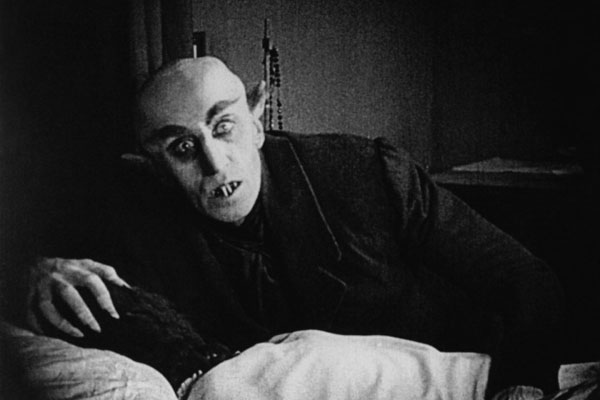Toyed with titling this entry Nosferatwo—but, no. At any rate, F.W. Murnau’s silent classic Nosferatu (Nosferatu, eine Symphonie des Grauens, 1922) is currently screening in London as part of the BFI’s months-long Gothic season, which, beginning on Halloween, will also feature Werner Herzog‘s Nosferatu the Vampyre (Nosferatu: Phantom der Nacht, 1979). Herzog’s homage begins a two-week run at New York’s Film Forum today, and on Monday, Murnau’s original screens there with live piano accompaniment by Steve Sterner. And a new restoration will be out on Blu-ray next month in the UK from Masters of Cinema and in the US from Kino Lorber.
In a piece on both films for the Quietus, Yasmeen Khan notes that, in Herzog on Herzog, a 650-page interview edited by Paul Cronin (a second edition is due next year), “the director claims that, ‘I never thought of my film Nosferatu as being a remake. It stands on its own feet as an entirely new version… My Nosferatu has a different context, different figures and a somewhat different story.’ Perhaps Herzog’s distinction is philosophical; perhaps he is arguing that without the intention to completely re-shoot a film isn’t a remake. And the context of Europe in 1979 is inarguably different from that of 1922. Otherwise, though, his statement is a curious one; his Nosferatu echoes Murnau’s almost scene for scene, detail for detail, theme for theme…. It feels like a very personal film, in any case. As Herzog puts it himself, ‘The images found in vampire films have a quality beyond our usual experiences in the cinema. For me, genre means an intensive, almost dreamlike stylization on screen, and I feel the vampire genre is one of the richest and most fertile cinema has to offer. There is fantasy, hallucination, dreams and nightmares, visions, fear, and of course, mythology.'”
“It would take a special kind of artist to measure up to Max Schreck’s iconic performance in Murnau’s film,” writes Keith Uhlich in Time Out New York. A “crazy one, really, and who better than Herzog’s perpetually hotheaded muse Klaus Kinski?… There are few sequences in Herzog’s oeuvre as chillingly poetic as the one in which the plague descends on Lucy [Isabelle Adjani] and Jonathan’s [Bruno Ganz] hometown. Vermin run rampant, the bourgeoisie cheerily toast their own demise, and the Count himself slinks around, in one of the film’s most haunting images, with a black coffin tucked lovingly under his arm. This is a pinnacle of horror cinema: atmospheric, rhapsodic and—especially in the slow-burn confrontations between Lucy and her otherworldly inamorato—achingly transcendent.”
“Herzog toys with the audience’s sexual fears,” adds Nicholas Thomson at the L: “physical deterioration, the mysterious foreigner and, most insidiously, the point at which possession becomes sadistic.”
Murnau’s “romantic fantasia of evil helped invent a whole vocabulary of thriller storytelling,” writes the Guardian‘s Peter Bradshaw. “Murnau shifted the geographical centre of gravity east in his unauthorized adaptation of Bram Stoker‘s Dracula: now it is Germany, not England, where the sinister Count Orlok, that strange fanged sprite played by Max Schreck, aspires to live. Having been quarantined for so long in the trackless Translyvanian forests, he has now made a satanic decision to spread his malaise into the rational, scientific, bourgeois Europe of the 19th century.”
“The perfume of unfulfilled erotic desire hangs over the film,” writes David Jenkins at Little White Lies, “to the point where one might see it as one the great tragic romances as much as a film about a crazed killer who’s literally baying for blood.”
More from Kieron Tyler (Arts Desk) and Lindsay Tudor (Electric Sheep). And for the BFI, Pamela Hutchinson lists “10 great silent horror films.” In two recent entries, I’ve pointed to two rich reads, Graham Fuller‘s at Artinfo addressing the anti-Semitism of Murnau’s original and David Kalat‘s at Movie Morlocks, a plea for recognition of Albin Grau’s contribution to the film.
Meantime, many Octobers ago—and I might say I can’t believe it’s been eleven years, but I won’t, because I can—I wrote a piece called “Where the Horror Came From,” which became a sort of prelude to my primer on German Expressionism for Greencine. Naturally, Murnau’s Nosferatu features prominently in both.
Update, 10/27: Silent film accompanist Neil Brand in Silent London: “Over a lifetime of playing this masterpiece I have noticed that in two vital areas scriptwriter Henrik Galeen and director F.W. Murnau actually created a new monster that Stoker would barely have recognized—firstly Van Helsing is a small-part character who is in no way responsible for Dracula’s destruction; secondly Nosferatu, minus Dracula’s brides, only has eyes for only one woman—Mina Harker. And it’s beauty that kills the beast.”
Updates, 11/1: “Even if [Herzog] had not spoken extensively about his keen desire to make a film which allowed him to reconnect,” writes BFI programmer Geoff Andrew, “somehow, with an earlier, illustrious era of German filmmaking—the era dominated by Fritz Lang and Murnau—the opening credits of his film announce very clearly that this is no straightforward or direct remake. The grotesque close-ups of mummified humans, victims of a nineteenth-century cholera epidemic kept in a Mexican museum which Herzog had first visited in the 1960s, have no equivalent in Murnau’s film, and are the very first manifestation of Herzog’s fascination with themes which his predecessor barely dealt with: the condition of immortality, which a great many individuals dream of attaining but which, for Klaus Kinski’s vampire Count, is a source of ceaseless torment, and its counterpart—the profound death-wish of humanity as a species.”
More from John Bleasdale (Electric Sheep), Peter Bradshaw (Guardian, 5/5), Tom Huddleston (Time Out London, 3/5), Geoffrey Macnab (Independent, 5/5), and Tim Robey (Telegraph, 5/5).
For news and tips throughout the day every day, follow @KeyframeDaily on Twitter and/or the RSS feed. Get Keyframe Daily in your inbox by signing in at fandor.com/daily.




